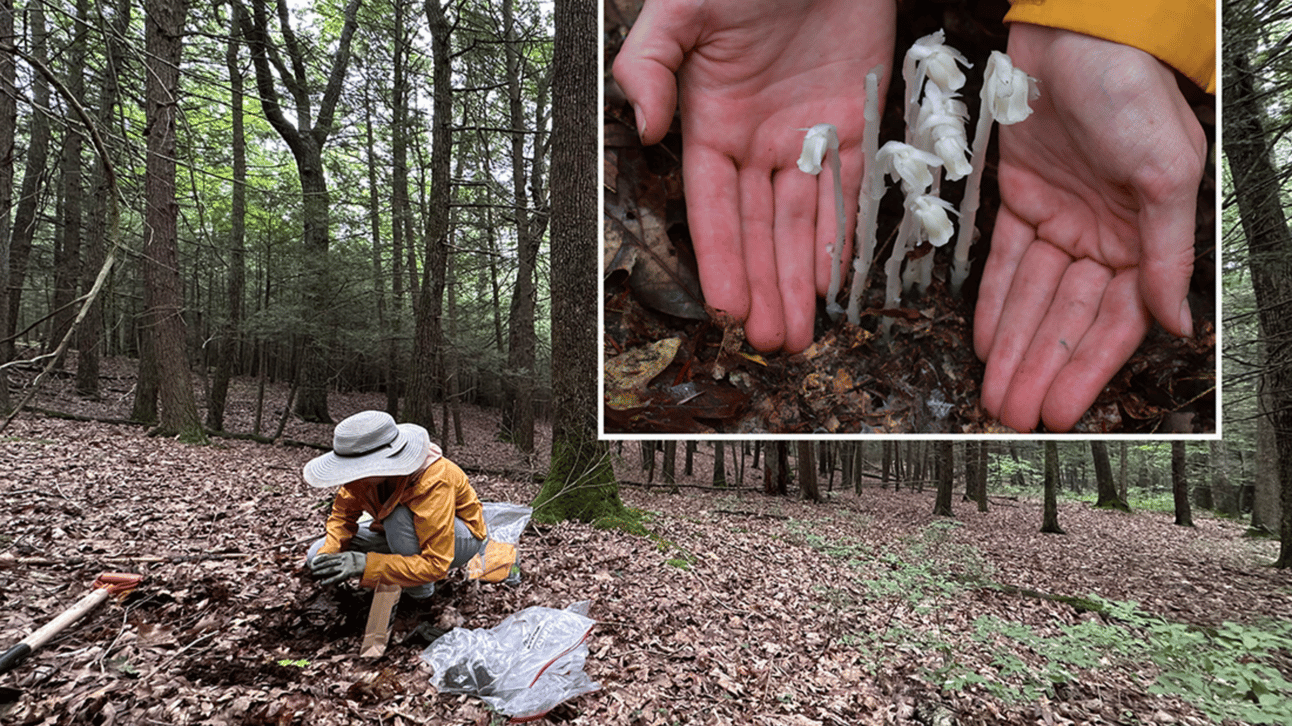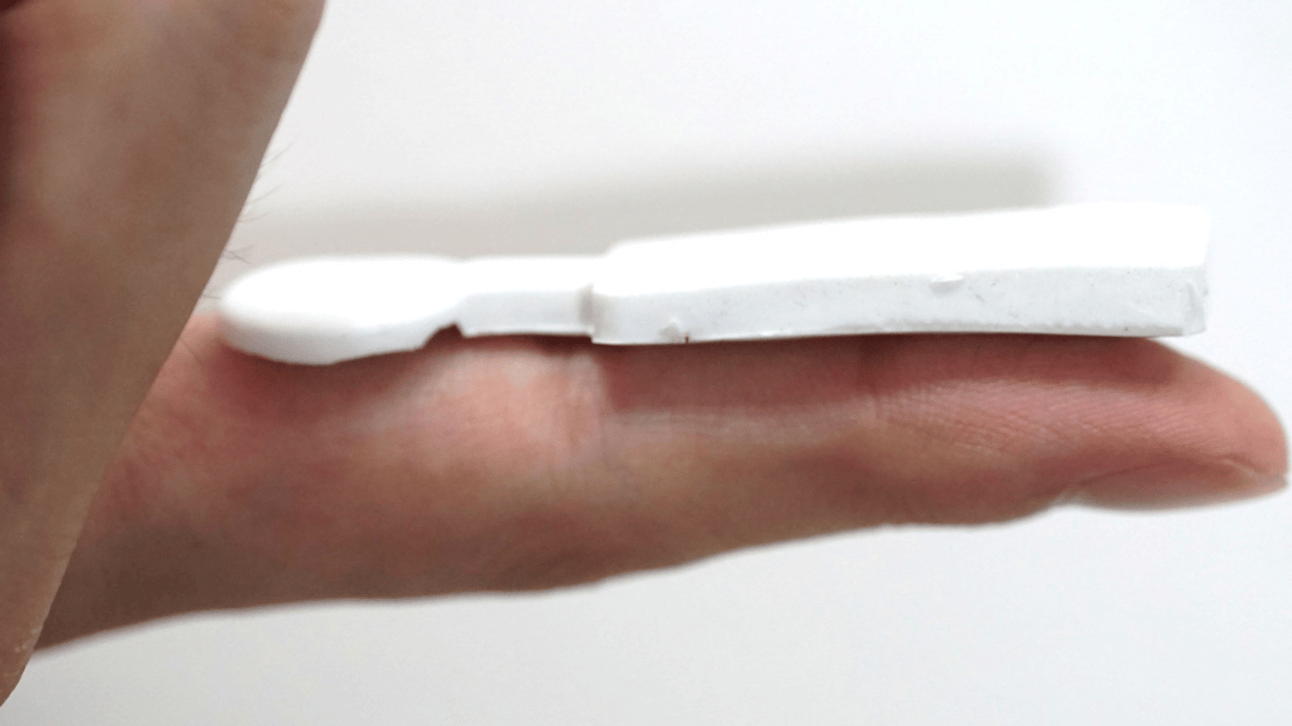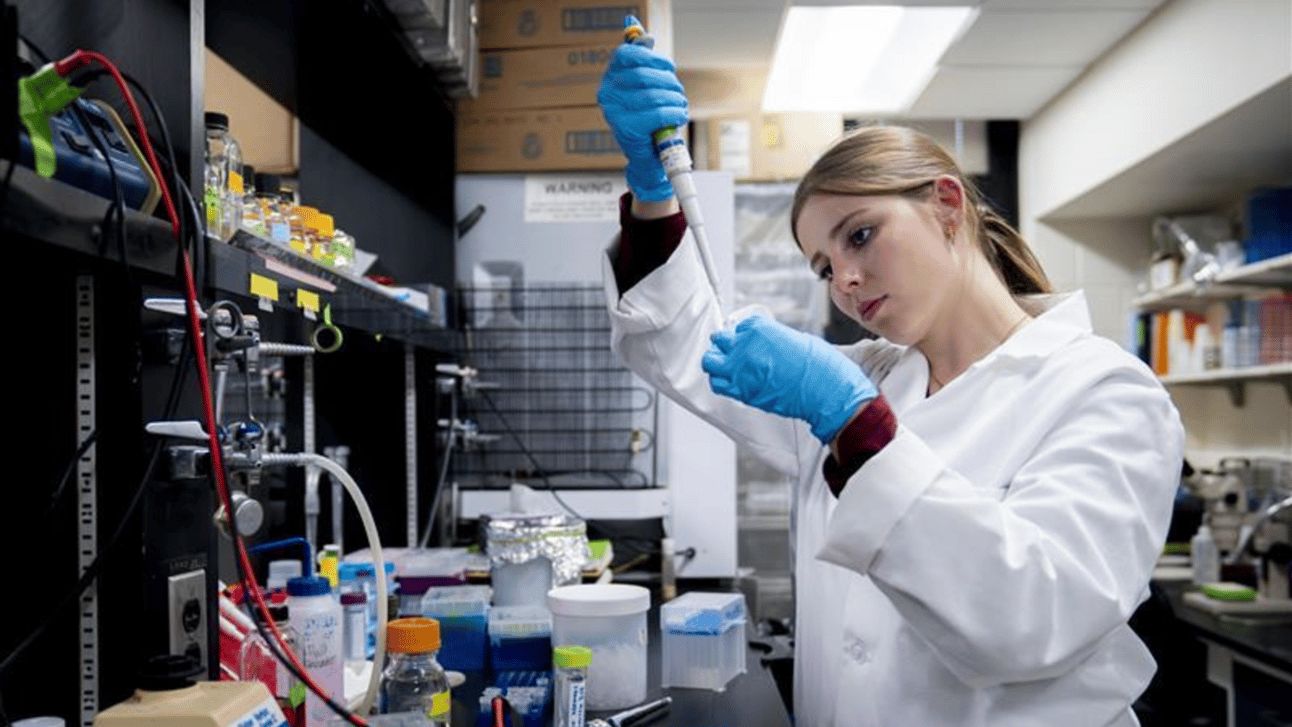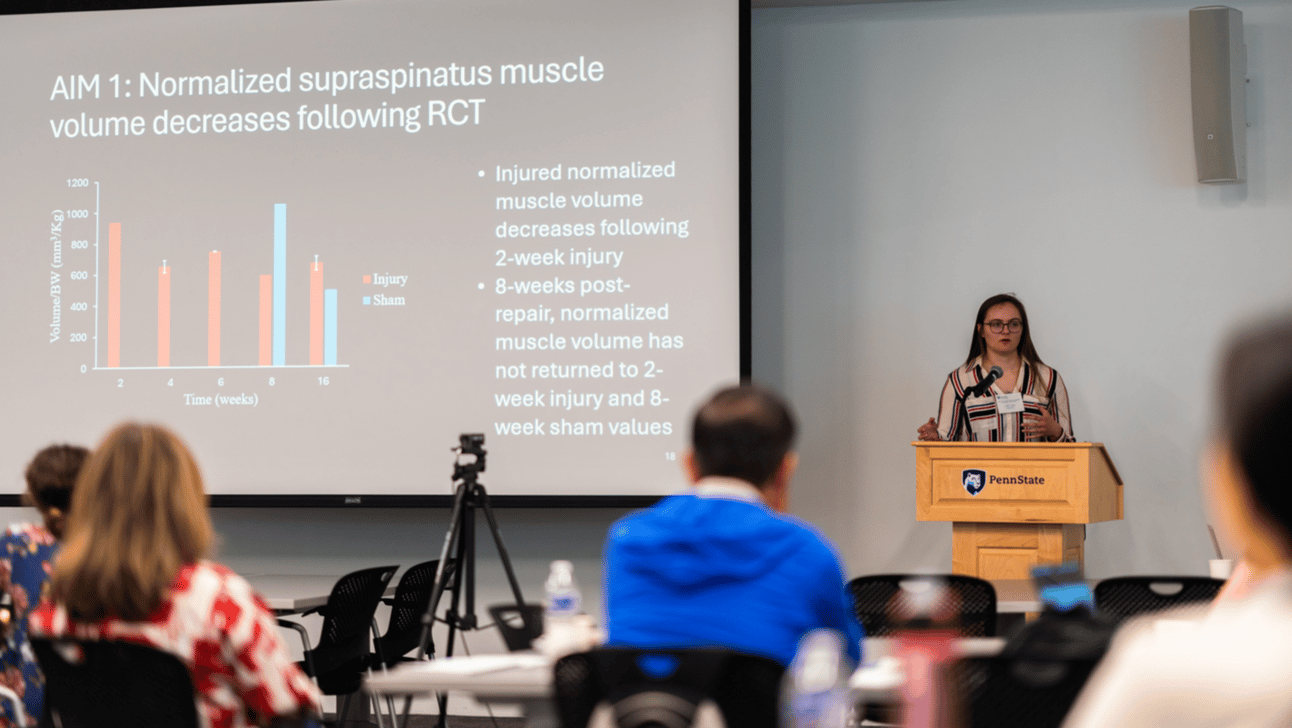Huck Institutes News | April 2025
This month, we honor one of Huck’s longest-serving leaders, Professor of Biology James Marden, as he prepares to retire after a long and distinguished career. Marden has been a member of Huck’s executive team since 2014, serving as associate director of operations since 2016. Read on below to learn more about his lasting, transformational impact on the life sciences research community at Penn State.
★ Feature Story
Celebrating James Marden
After a decade of exceptional service to the Huck Institutes of the Life Sciences and a distinguished academic career spanning four decades, James Marden, professor of biology and associate director of operations, will retire from Penn State at the end of June 2025.
Throughout his tenure, Marden played a pivotal role in building infrastructure that has propelled Penn State's research enterprise to new heights. His leadership helped create the CSL-Behring Fermentation Facility and later the Sartorius Cell Culture Facility, initiatives that leveraged corporate partnerships and philanthropy to enhance Penn State's research and workforce development capabilities.
"Huck's license to operate freely and creatively across the university allowed me to catalyze and convene a diverse team who worked together to make things happen."
Another major accomplishment under Marden's stewardship was the establishment of the Cryo-Electron Microscopy Core, a world-class facility that now enables Penn State researchers to explore the molecular world at atomic resolution.
Marden’s scientific curiosity and versatility have always set him apart. His research career bridged disciplines, encompassing functional genomics, biomechanics, physiology, ecology, and evolutionary biology. Working primarily with insects, Marden examined physiological mechanisms and ecological dynamics, and more recently expanded into studying allelic variation in tropical trees.
“Jim is impossible to place in a disciplinary box—biologist, ecologist, physiologist, entomologist, bioinformatician, genomics, gene expression… the best I could ever come up with was the near meaningless ‘quantitative life scientist.’ He really embodies the Huck interdisciplinarity.”
As he transitions into retirement, James Marden leaves behind a legacy of scholarship, leadership, and a stronger, more connected life sciences community at Penn State.
Slice of Life
Differences among the DNA of seven ape species — including humans — are greater than originally thought, according to an international team led by researchers at Penn State, the National Human Genome Research Institute (NHGRI) and the University of Washington. They revealed the genetic details with “complete” reference genomes, which are standardized sequences of a species’ genes and other chromosomal regions.
Complete reference genomes allow for comparison between species, enabling researchers to look for variations in DNA that might impact a species’ health and survival. Assembling full DNA sequences from one end of each chromosome to the other was previously not possible due to technological and algorithmic limitations. The findings, published April 9 in Nature, shed light on primate evolution and highlight new species-specific genes and genes with multiple copies.
"This work uncovered novel adaptive signatures in genes related to diet, immune response and cellular activity, offering precise insights into the evolutionary pressures shaping great ape genomes.”
Despite a long history of traditional medicinal use in the United States, the collection, consumption and efficacy of the peculiar forest plant aptly named ghost pipe, scientific name Monotropa uniflora, remains a mystery. Now, with social media and the internet driving a resurgence in the harvest and economic trade of the parasitic species — which appears strangely white because it is devoid of chlorophyll — a research team from Penn State has taken the first step toward documenting its new status.
“This study is the first to scientifically document use of ghost pipe in North America, along with the growing influence of social media and the internet on how and why people are turning to ghost pipe as a medicinal plant. As a wild harvested species, little has been documented about its use throughout the U.S. and any growing conservation needs. This study helps to inform future research and education efforts so that consumer safety and wild conservation efforts can both be appropriately targeted and aligned.”
In findings recently published in Economic Botany, the researchers reported the results of a digital survey they conducted within the United States asking participants whether they have foraged, consumed or prescribed ghost pipe. Notably, respondents overwhelmingly reported consuming ghost pipe in tincture form and for pain management.
Saying one thing while feeling another is part of being human, but bottling up emotions can have serious psychological consequences like anxiety or panic attacks. To help health care providers tell the difference, a team led by scientists at Penn State has created a stretchable, rechargeable sticker that can detect real emotions — by measuring things like skin temperature and heart rate — even when users put on a brave face.
The researchers recently unveiled the wearable patch that can simultaneously and accurately track multiple emotional signals in a study published in the journal Nano Letters and filed a provisional patent for the technology.
“This is a new and improved way to understand our emotions by looking at multiple body signals at once. Relying only on facial expressions to understand emotions can be misleading. People often don't visibly show how they truly feel, so that’s why we’re combining facial expression analysis with other important physiological signals, which will ultimately lead to better mental health monitoring and support.”
When it came to tracking real emotions, the researchers tested how well the device tracked the psychological responses of the same participants as they watched video clips designed to elicit emotions. The device correctly identified emotions with 88.83% accuracy, with the sensors confirming that the psychological responses were consistent with known links between emotions and psychological reactions, such as increases in skin temperature and heart rate during surprise and anger.
Accolades & Awards
The National Academies of Sciences, Engineering, and Medicine recently appointed Christina Grozinger, Publius Vergilius Maro Professor of Entomology and director of the Huck Institutes of the Life Sciences at Penn State, to an 18-member study committee to examine the status of insects in North America.
“There have been alarming reports of insect declines across the world, including a recent study that found a 22% decline in butterflies in the United States over the last 20 years. This committee will holistically evaluate the existing data on insect declines in North America, identify species and groups that are especially at risk, and provide recommendations for future research priorities and strategies to reduce or reverse these declines.”
The National Academies provides expert advice on pressing scientific challenges facing the nation and world — in this case, the ad-hoc committee will conduct a study “to assess trends in insect abundance, identify research priorities and suggest actions to slow insect losses in areas identified as most vulnerable and most critical to ecosystem function,” according to their website.
Heather Hines, Associate Professor of Biology and Entomology, has been named Interim Director of the Center for Pollinator Research (CPR) and the Insect Biodiversity Center (IBC). Hines is succeeding Christina Grozinger, Publius Vergilius Maro Professor of Entomology and director of the Huck Institutes of the Life Sciences.
As Hines steps into her role as interim director, her vision for the future of the CPR and IBC centers is one of continued innovation, collaboration, and community engagement. She is particularly excited to expand the centers' outreach efforts, enhance lab coordination, and integrate the arts and sciences in a way that engages diverse audiences on pollinator-relevant issues.
“In addition to the opportunity for growth in leadership, I am eager to help facilitate networking and enhance research opportunities and synergies among the excellent community of pollinator biologists and insect biodiversity scientists here at Penn State. I am excited to do my part to sustain and grow collaborative science in these centers.”
Hines will serve as interim director of both Centers in advance of the formal process to identify the new director in the coming academic year.
Next-Gen Science
The Life Sciences Symposium, organized by the Huck Graduate Student Advisory Committee (HGSAC), is set to showcase student research on May 23. The Symposium is the marquee event organized by the HGSAC every year, and 2025 marks its ninth edition, for which the organizers forecast a record turnout.
“We are expecting about 200 attendees. This year, we received over 100 abstracts submitted by graduate students, undergraduate researchers, and postdoctoral researchers at Penn State, which is the most we have ever received.”
This year’s theme centers on “bioethics in life sciences research.” Debra Matthews—professor of genetic medicine at Johns Hopkins University and associate director for research and programs at the Berman Institute of Bioethics—has been confirmed as the symposium’s keynote speaker.
Maria Lovallo is a Penn State undergrad from Spring Mills, PA, majoring in Microbiology with a minor in Plant Pathology & Environmental Microbiology. She is also a teaching assistant in Biochemistry and Molecular Biology, and a member of the Huck Institutes’ One Health Microbiome Center.
Under the mentorship of Claire Thomas, associate professor of biology and of biochemistry and molecular biology, and Emily Davenport, assistant professor of biology, Lovallo leads a project focusing on investigating the effects of the microbiome on flight physiology in the commonly studied fruit fly, Drosophila melanogaster. She is looking for variations in flight endurance or acute flight response that are caused by changes in microbiome composition and hopes to integrate those observations with any observed changes in the metabolic activity of flight muscles.
“If I had any advice to give to those looking to enter research as an undergraduate, it would be to immerse yourself in the experience and be unafraid to ask questions!”
After graduating in spring of 2025, Lovallo will be pursuing her PhD in Molecular and Cell Biology with a focus on Microbiology at the University of Connecticut. Her long-term goal is to build a career in academia, balancing her own research with mentoring and teaching.
Core Topics
Researchers from across Penn State and beyond gathered at the HUB-Robeson Center last Friday for the first-ever MRI Symposium hosted by the Huck Institutes’ High-Field Magnetic Resonance Imaging Facility. Led by Director Thomas Neuberger, the event highlighted cutting-edge advances in MRI applications for both life sciences and materials research, fostering new interdisciplinary collaborations and showcasing Penn State’s leadership in high-field imaging.
Site Update
We’re excited to introduce a new way to keep up with Huck events. In addition to our event list, you can now explore our new calendar, which allows you to sort events by category and add them directly to your personal calendar. It’s easier than ever to stay informed, get involved, and make the most of everything happening across the Huck!
Want to see your Huck event on our new calendar? Submit it here.
Help Wanted
The Huck Institutes of the Life Sciences seeks two highly motivated, collaborative, and creative graduate assistants to join the Skilled Training in Administration and Institutional Research (STAIR) program this summer.
These are part-time (20 hours/week) paid graduate assistant positions:
Design and build a new website for the STAIR program, ensuring functionality, accessibility, and a professional aesthetic.
Support marketing and branding efforts, including communication and outreach for STAIR Summit 2026.
Collaborate with instructional designers and subject matter experts to design, develop and disseminate training for research administration.
Assist in organizing and facilitating training sessions, workshops, and focus groups.

The Huck Catalysis (Huck C) program coordinates university-wide interdisciplinary life sciences research development and collaboration activities with an emphasis on scholarship that crosses multiple academic units. Working with other units, Huck C provides support and programming to facilitate research partnerships, support strategic planning, identify funding opportunities, form interdisciplinary collaborations, and submit these proposals through SIRO.
The following are exceptionally innovative, recurring complex interdisciplinary research and education projects that require large-scale, long-term planning:
Curiosity-driven research falling within three focus areas: Building Life, Principles of Life, and Signs of Life. Cycle: 2-5 Years. If you plan on applying, contact Karen Kemirembe, associate director of foundation relations at [email protected].
Funding Available: $1.5M
Internal Submission Deadline: May 28, 2025
Funding Organization's Deadline: June 4, 2025
The intent of this NOFO is to encourage applications from academic, biotechnology, biomedical device industry, or pharmaceutical industry investigators interested in participating with the National Institute of Mental Health (NIMH) in a National Cooperative Drug/Device Discovery/Development Group (NCDDG) program. Partnerships between academia and industry are strongly encouraged.
Posted: January 15, 2025
Contact: [email protected]
The purpose of this funding opportunity is to accelerate innovative drug and device therapies translation from discovery to early human studies. This NOFO encourages applications to advance the discovery, preclinical development, and proof of concept (PoC) testing of new, rationally based candidate agents and neurostimulation approaches to treat mental disorders, and to develop novel ligands and circuit-engagement devices as tools to further characterize existing or to validate new drug/device targets. Partnerships between academia and industry are strongly encouraged.
Posted: January 15, 2025
Contact: [email protected]
Supports non-incremental research designed to reduce risk of or prevent the development of Alzheimer’s disease and/or Alzheimer's disease related dementias (AD/ADRD). Allowable research includes projects utilizing animal models as well as clinical research projects.
Posted: April 18, 2025
Contact: [email protected]

Huck research attracts media attention from around the world. Here are a few highlights from this month:
Novel AI tool may help protect autoimmune disease risk ‘as early as birth.’ [Healio]
How plant aromas shape insect diets. [Earth.com]
Popular remedy for insomnia may increase risk of disability. [New York Post]
The air might be dirtier than you think. [StudyFinds]
This wearable sticker can read emotions. [Popular Science]
How Earth’s warming is affecting Americans. [The Daily Item]
Vitamin D matters during the first trimester of pregnancy. [Academic Minute]
Apple genus evolution revealed. [Earth.com]
Penn State experts weigh in on measles outbreak. [The Daily Collegian]












